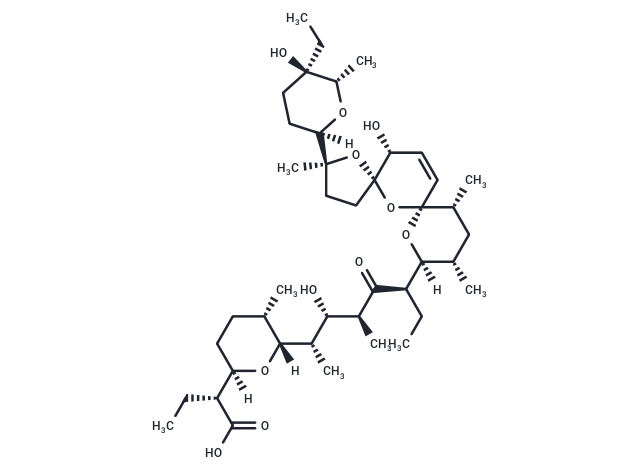Shopping Cart
Remove All Your shopping cart is currently empty
Your shopping cart is currently empty
Salinomycin (Procoxacin), a polyether potassium ionophore antibiotic, specifically inhibits the growth of gram-positive bacteria, acts as a potent inhibitor of Wnt/β-catenin signaling by blocking Wnt-induced LRP6 phosphorylation, and demonstrates selective activity against human cancer stem cells.

| Pack Size | Price | USA Warehouse | Global Warehouse | Quantity |
|---|---|---|---|---|
| 1 mg | $32 | In Stock | In Stock | |
| 2 mg | $45 | In Stock | In Stock | |
| 5 mg | $74 | In Stock | In Stock | |
| 10 mg | $118 | In Stock | In Stock | |
| 25 mg | $219 | In Stock | In Stock | |
| 50 mg | $389 | In Stock | In Stock | |
| 100 mg | $558 | In Stock | In Stock |
| Description | Salinomycin (Procoxacin), a polyether potassium ionophore antibiotic, specifically inhibits the growth of gram-positive bacteria, acts as a potent inhibitor of Wnt/β-catenin signaling by blocking Wnt-induced LRP6 phosphorylation, and demonstrates selective activity against human cancer stem cells. |
| In vitro | Salinomycin, a potent Wnt signaling cascade inhibitor and antibiotic potassium ionophore, demonstrates significant anticancer properties. It induces apoptosis in malignant lymphocytes within 48 hours, showing a mean IC50 value of 230 nM. Notably, Salinomycin has been identified as a selective inhibitor of breast cancer stem cells (CSCs)[1], effectively inhibiting both normal and Cisp-resistant SW620 cancer cells with IC50 values of 1.54±0.23 μM and 0.32±0.05 μM, respectively. It uniquely targets and kills CSCs and therapy-resistant cancer cells. Continuous treatment with Salinomycin over 48 hours increases the apoptotic cell count significantly in Cisp-resistant SW620 cells compared to non-resistant SW620 cells, as observed under a microscope and confirmed through flow cytometric analysis of cell apoptosis. The apoptotic rate is markedly higher in Cisp-resistant SW620 cells (37.82±3.63%) than in standard SW620 cells (16.78±2.56%) (p<0.05)[2]. |
| In vivo | Upon administering doses of 4 mg/kg and 8 mg/kg Salinomycin (Sal), alongside 10 uL/g saline water to mice for a duration of 6 weeks, followed by their sacrifice, a significant reduction in liver tumor size is observed in the Sal-treated groups compared to the controls. Tumor diameters decrease notably from 12.17 mm to 3.67 mm (p<0.05), and volumes, calculated as V=length×width^2×0.5, diminish from 819 mm^3 to 25.25 mm^3 (p<0.05). Subsequent analyses, involving HE staining, immunohistochemistry, and TUNEL assays, are conducted to evaluate Salinomycin's anti-tumor efficacy. Results show altered liver cancer tissue structure, reduced PCNA expression, and higher apoptosis rates in Sal-treated mice, indicating significant anti-tumor activity. Furthermore, an increase in the Bax/Bcl-2 ratio and a decrease in β-catenin protein expression corroborate Salinomycin's effectiveness. Salinomycin, a monocarboxylic acid polyether antibiotic derived from Streptomyces albus fermentation, exhibits a unique cyclic structure enabling it to bind with pathogenic microorganisms and extracellular cations of coccidia, particularly K+, Na+, Rb+, effectively altering intra- and extracellular ion concentrations[4][5]. |
| Synonyms | Procoxacin |
| Molecular Weight | 751 |
| Formula | C42H70O11 |
| Cas No. | 53003-10-4 |
| Smiles | [H][C@@]1(CC[C@H](C)[C@@]([H])(O1)[C@@H](C)[C@H](O)[C@H](C)C(=O)[C@H](CC)[C@@]1([H])O[C@@]2(O[C@@]3(CC[C@](C)(O3)[C@@]3([H])CC[C@](O)(CC)[C@H](C)O3)[C@H](O)C=C2)[C@H](C)C[C@@H]1C)[C@@H](CC)C(O)=O |
| Relative Density. | 1.18 g/cm3 |
| Storage | keep away from moisture | Powder: -20°C for 3 years | In solvent: -80°C for 1 year | Shipping with blue ice/Shipping at ambient temperature. |
| Size | Quantity | Unit Price | Amount | Operation |
|---|

Copyright © 2015-2025 TargetMol Chemicals Inc. All Rights Reserved.